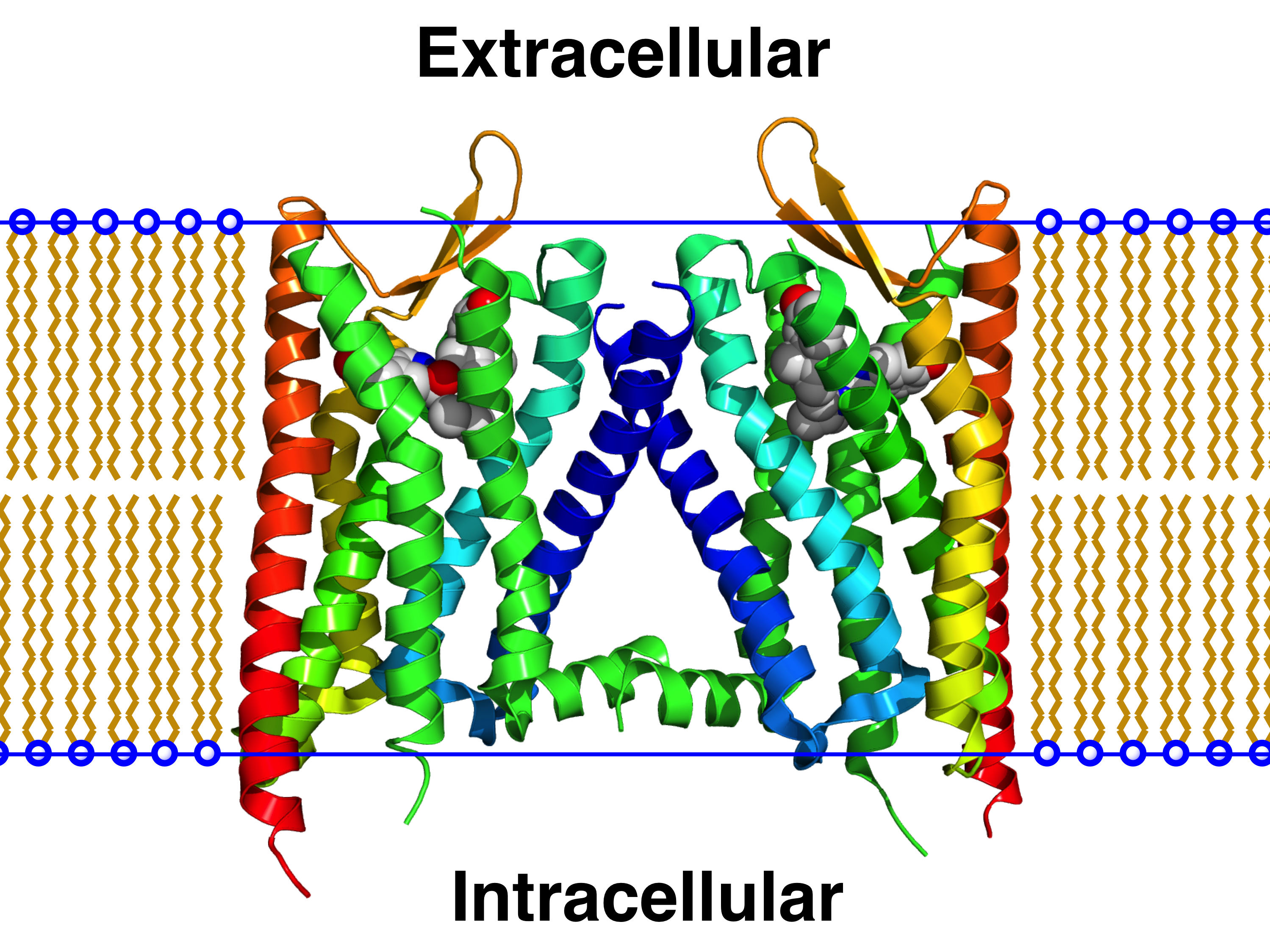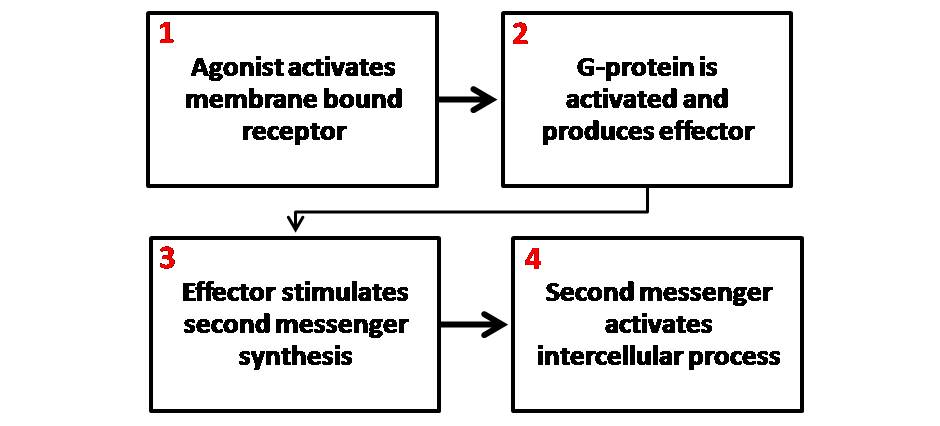|
Heteromer
A heteromer is something that consists of different parts; the antonym of homomeric. Examples are: Biology * Spinal neurons that pass over to the opposite side of the spinal cord. * A protein complex that contains two or more different polypeptides. Pharmacology * Ligand-gated ion channels such as the nicotinic acetylcholine receptor and GABAA receptor are composed of five subunits arranged around a central pore that opens to allow ions to pass through. There are many different subunits available that can come together in a wide variety of combinations to form different subtypes of the ion channel. Sometimes the channel can be made from only one type of subunit, such as the α7 nicotinic receptor, which is made up from five α7 subunits, and so is homomerrather than a heteromer, but more commonly several different types of subunit will come together to form a heteromeric complex (e.g., the α4β2 nicotinic receptor, which is made up from two α4 subunits and three β2 subunit ... [...More Info...] [...Related Items...] OR: [Wikipedia] [Google] [Baidu] |
Adenosine A2A Receptor
The adenosine A2A receptor, also known as ADORA2A, is an adenosine receptor, and also denotes the human gene encoding it. Structure This protein is a member of the G protein-coupled receptor (GPCR) family which possess seven transmembrane alpha helices, as well as an extracellular N-terminus and an intracellular C-terminus. Furthermore, located in the intracellular side close to the membrane is a small alpha helix, often referred to as helix 8 (H8). The crystallographic structure of the adenosine A2A receptor reveals a ligand binding pocket distinct from that of other structurally determined GPCRs (i.e., the beta-2 adrenergic receptor and rhodopsin).; Below this primary ( orthosteric) binding pocket lies a secondary ( allosteric) binding pocket. The crystal-structure of A2A bound to the antagonist ZM241385 (PDB code: 4EIY) showed that a sodium-ion can be found in this location of the protein, thus giving it the name 'sodium-ion binding pocket'. Heteromers The actions of th ... [...More Info...] [...Related Items...] OR: [Wikipedia] [Google] [Baidu] |
GPCR Oligomer
A GPCR oligomer is a protein complex that consists of a small number ( ''oligoi'' "a few", ''méros'' "part, piece, component") of G protein-coupled receptors (GPCRs). It is held together by covalent bonds or by intermolecular forces. The subunits within this complex are called protomers, while unconnected receptors are called monomers. Receptor homomers consist of identical protomers, while heteromers consist of different protomers. Receptor homodimers – which consist of two identical GPCRs – are the simplest homomeric GPCR oligomers. Receptor heterodimers – which consist of two different GPCRs – are the simplest heteromeric GPCR oligomers. The existence of receptor oligomers is a general phenomenon, whose discovery has superseded the prevailing paradigmatic concept of the function of receptors as plain monomers, and has far-reaching implications for the understanding of neurobiological diseases as well as for the development of drugs. Discovery For a long time ... [...More Info...] [...Related Items...] OR: [Wikipedia] [Google] [Baidu] |
Dopamine Receptor D1
Dopamine receptor D1, also known as DRD1. It is one of the two types of D1-like receptor family receptors D1 and D5. It is a protein that in humans is encoded by the DRD1 gene. Tissue distribution D1 receptors are the most abundant kind of dopamine receptor in the central nervous system. Northern blot and in situ hybridization show that the gene expression, mRNA expression of DRD1 is highest in the dorsal striatum (caudate nucleus, caudate and putamen) and ventral striatum (nucleus accumbens and olfactory tubercle). Lower levels occur in the basolateral amygdala, cerebral cortex, septum, thalamus, and hypothalamus. The DRD1 gene expresses primarily in the caudate putamen in humans, and in the caudate putamen, the nucleus accumbens and the olfactory tubercle in mouse. Structure The dopamine receptor D1 (D1R) is a Gs-coupled GPCR characterized by a canonical seven-transmembrane (TM) helical domain, with a ligand-binding pocket located Extracellular space, extracellularl ... [...More Info...] [...Related Items...] OR: [Wikipedia] [Google] [Baidu] |
GABAA Receptor
The GABAA receptor (GABAAR) is an ionotropic receptor and ligand-gated ion channel. Its endogenous Ligand (biochemistry), ligand is γ-aminobutyric acid (GABA), the major inhibitory neurotransmitter in the central nervous system. Accurate regulation of GABAergic transmission through appropriate developmental processes, specificity to neural cell types, and responsiveness to activity is crucial for the proper functioning of nearly all aspects of the central nervous system (CNS). Upon opening, the GABAA receptor on the Chemical synapse, postsynaptic cell is selectively permeable to Chloride, chloride ions () and, to a lesser extent, Bicarbonate, bicarbonate ions (). GABAAR are members of the ligand-gated ion channel receptor superfamily, which is a chloride channel family with a dozen or more heterotetrametric subtypes and 19 distinct subunits. These subtypes have distinct brain regional and subcellular localization, age-dependent expression, and the ability to undergo plastic alt ... [...More Info...] [...Related Items...] OR: [Wikipedia] [Google] [Baidu] |
Nicotinic Acetylcholine Receptor
Nicotinic acetylcholine receptors, or nAChRs, are Receptor (biochemistry), receptor polypeptides that respond to the neurotransmitter acetylcholine. Nicotinic receptors also respond to drugs such as the agonist nicotine. They are found in the central and peripheral nervous system, muscle, and many other tissues of many organisms. At the neuromuscular junction they are the primary receptor in muscle for motor nerve-muscle communication that controls muscle contraction. In the peripheral nervous system: (1) they transmit outgoing signals from the presynaptic to the postsynaptic cells within the Sympathetic nervous system, sympathetic and parasympathetic nervous system, and (2) they are the receptors found on skeletal muscle that receive acetylcholine released to signal for muscular contraction. In the immune system, nAChRs regulate inflammatory processes and signal through distinct intracellular pathways. In insects, the cholinergic system is limited to the central nervous system. ... [...More Info...] [...Related Items...] OR: [Wikipedia] [Google] [Baidu] |
Homomeric
Something that is composed of one repeating subunit, the antonym of heteromeric. It is often used to describe proteins made up of multiple identical repeating polypeptide Peptides are short chains of amino acids linked by peptide bonds. A polypeptide is a longer, continuous, unbranched peptide chain. Polypeptides that have a molecular mass of 10,000 Da or more are called proteins. Chains of fewer than twenty ... chains e.g. beta galactosidase. References {{reflist ... [...More Info...] [...Related Items...] OR: [Wikipedia] [Google] [Baidu] |
Protein Complex
A protein complex or multiprotein complex is a group of two or more associated polypeptide chains. Protein complexes are distinct from multidomain enzymes, in which multiple active site, catalytic domains are found in a single polypeptide chain. Protein complexes are a form of protein quaternary structure, quaternary structure. Proteins in a protein complex are linked by non-covalent interactions, non-covalent protein–protein interactions. These complexes are a cornerstone of many (if not most) biological processes. The cell is seen to be composed of modular supramolecular complexes, each of which performs an independent, discrete biological function. Through proximity, the speed and selectivity of binding interactions between Enzyme, enzymatic complex and substrates can be vastly improved, leading to higher cellular efficiency. Many of the techniques used to enter cells and isolate proteins are inherently disruptive to such large complexes, complicating the task of determining ... [...More Info...] [...Related Items...] OR: [Wikipedia] [Google] [Baidu] |
Alpha-4 Beta-2 Nicotinic Receptor
The alpha-4 beta-2 nicotinic receptor, also known as the α4β2 receptor, is a type of nicotinic acetylcholine receptor implicated in learning, consisting of α4 and β2 subunits. It is located in the brain, where activation yields post- and presynaptic excitation, mainly by increased Na+ and K+ permeability. Stimulation of this receptor subtype is also associated with growth hormone secretion. People with the inactive CHRNA4 mutation Ser248Phe are an average of 10 cm (4 inches) shorter than average and predisposed to obesity. A 2015 review noted that stimulation of the α4β2 nicotinic receptor in the brain is responsible for certain improvements in attentional performance; among the nicotinic receptor subtypes, nicotine has the highest binding affinity at the α4β2 receptor (ki=1 ), which is also the primary biological target that mediates nicotine's addictive properties. The receptors exist in the two stoichiometries: *(α4)2(β2)3 receptors have high sensit ... [...More Info...] [...Related Items...] OR: [Wikipedia] [Google] [Baidu] |
Adenosine A1 Receptor
The adenosine A1 receptor (A1AR) is one member of the adenosine receptor group of G protein-coupled receptors with adenosine as endogenous ligand. Biochemistry A1 receptors are implicated in sleep promotion by inhibiting wake-promoting cholinergic neurons in the basal forebrain. A1 receptors are also present in smooth muscle throughout the vascular system. The adenosine A1 receptor has been found to be ubiquitous throughout the entire body. Signaling Activation of the adenosine A1 receptor by an agonist causes binding of Gi1/2/3 or Go protein. Binding of Gi1/2/3 causes an inhibition of adenylate cyclase and, therefore, a decrease in the cAMP concentration. An increase of the inositol triphosphate/ diacylglycerol concentration is caused by an activation of phospholipase C, whereas the elevated levels of arachidonic acid are mediated by DAG lipase, which cleaves DAG to form arachidonic acid. Several types of potassium channels are activated but N-, P-, and Q-type calc ... [...More Info...] [...Related Items...] OR: [Wikipedia] [Google] [Baidu] |
Second Messenger System
Second messengers are intracellular signaling molecules released by the cell in response to exposure to extracellular signaling molecules—the first messengers. (Intercellular signals, a non-local form of cell signaling, encompassing both first messengers and second messengers, are classified as autocrine signaling, autocrine, juxtacrine signalling, juxtacrine, paracrine signaling, paracrine, and endocrine system, endocrine depending on the range of the signal.) Second messengers trigger physiological changes at cellular level such as Cell proliferation, proliferation, cellular differentiation, differentiation, migration, survival, apoptosis and depolarization. They are one of the triggers of intracellular signal transduction cascades. Examples of second messenger molecules include cyclic adenosine monophosphate, cyclic AMP, cyclic guanosine monophosphate, cyclic GMP, inositol triphosphate, diacylglycerol, and calcium. First messengers are extracellular factors, often hormones or ... [...More Info...] [...Related Items...] OR: [Wikipedia] [Google] [Baidu] |
Cannabinoid Receptor 1
Cannabinoid receptor 1 (CB1), is a G protein-coupled cannabinoid receptor that in humans is encoded by the ''CNR1'' gene. And discovered, by determination and characterization in 1988, and cloned in 1990 for the first time. The human CB1 receptor is expressed in the peripheral nervous system and central nervous system. It is activated by endogenous cannabinoids called endocannabinoids, a group of retrograde neurotransmitters that include lipids, such as anandamide and 2-arachidonoylglycerol; plant phytocannabinoids, such as docosatetraenoylethanolamide found in wild dagga, the compound tetrahydrocannabinol which is an active constituent of the psychoactive drug cannabis; and synthetic analogs of tetrahydrocannabinol. CB1 is antagonized by the phytocannabinoid tetrahydrocannabivarin at low doses and at higher doses, it activates the CB1 receptor as an agonist, but with less potency than tetrahydrocannabinol. The primary endogenous agonist of the human CB1 receptor is ana ... [...More Info...] [...Related Items...] OR: [Wikipedia] [Google] [Baidu] |
British Journal Of Pharmacology
The ''British Journal of Pharmacology'' is a biweekly peer-reviewed medical journal covering all aspects of experimental pharmacology. It is published for the British Pharmacological Society by Wiley-Blackwell. It was established in 1946 as the ''British Journal of Pharmacology and Chemotherapy,'' and originally published by the British Medical Association. The journal obtained its current title in 1968, when the journal moved publisher to Macmillan. It has been published by Wiley-Blackwell since 2009. The current editor-in-chief is Péter Ferdinandy. Previous editors-in-chief include Amrita Ahluwalia, Ian McGrath, Humphrey Rang, Alan North, Phil Moore, Bill Large, and Tony Birmingham. A sister journal, also published for the British Pharmacological Society by Wiley-Blackwell, is the ''British Journal of Clinical Pharmacology''. The journal publishes research papers, review articles, commentaries and correspondence in all fields of pharmacology. It also publishes themed issues, a ... [...More Info...] [...Related Items...] OR: [Wikipedia] [Google] [Baidu] |




